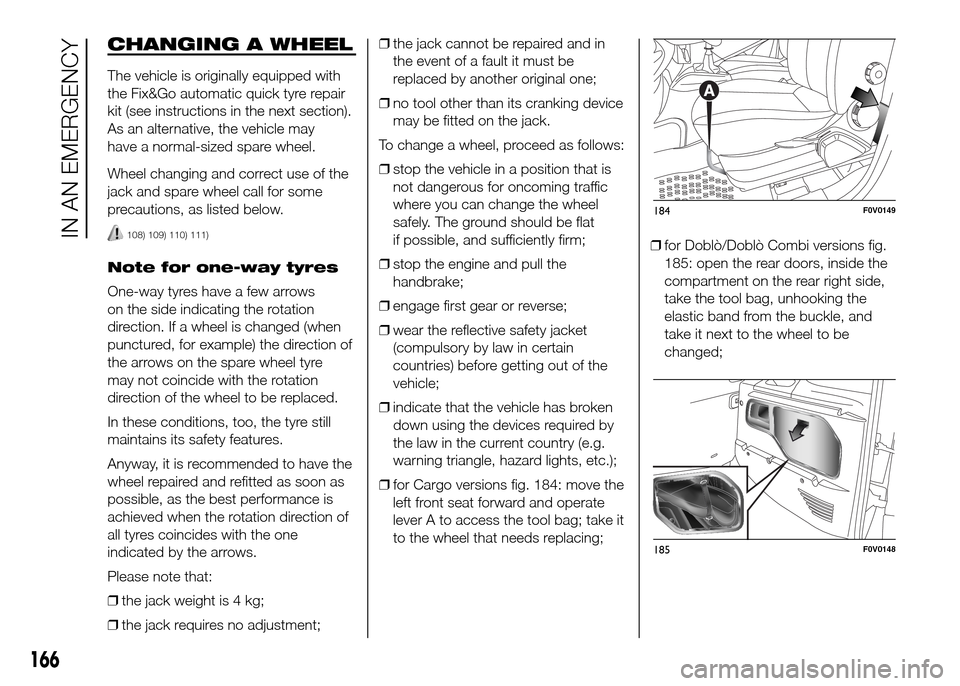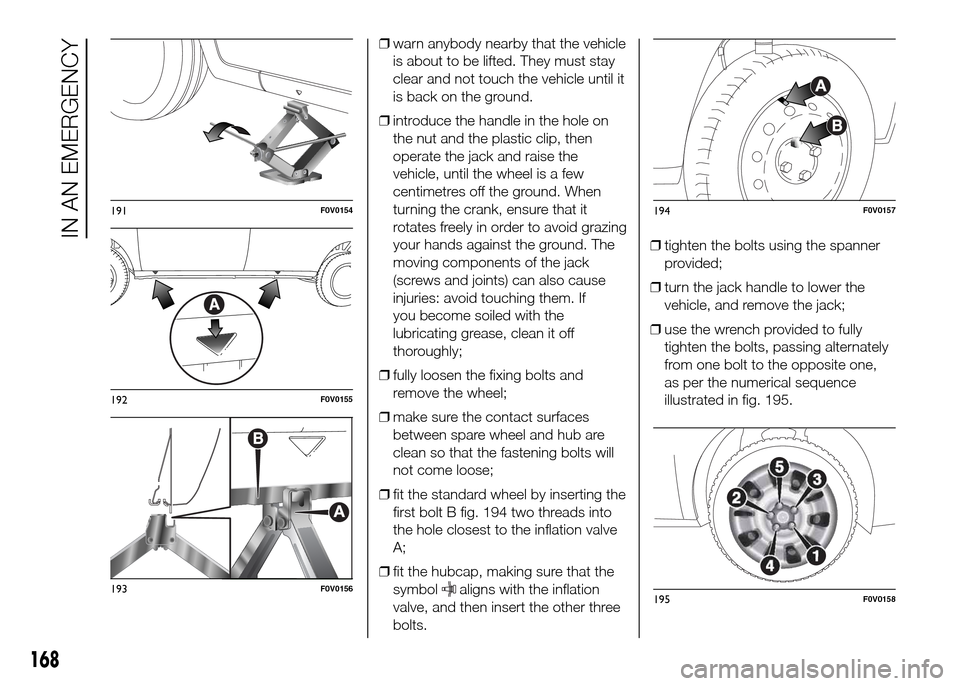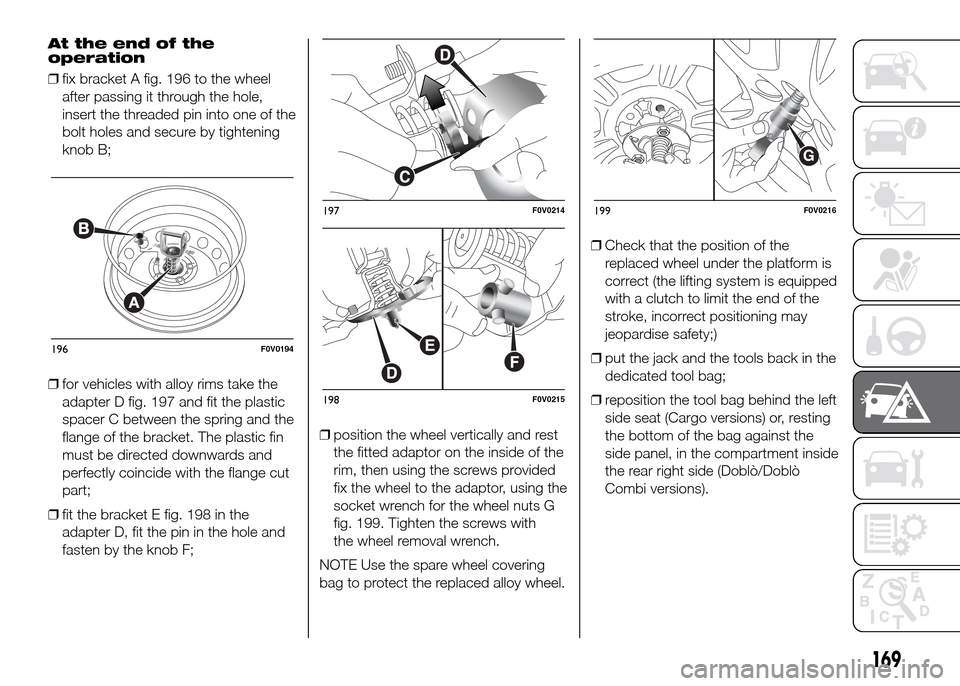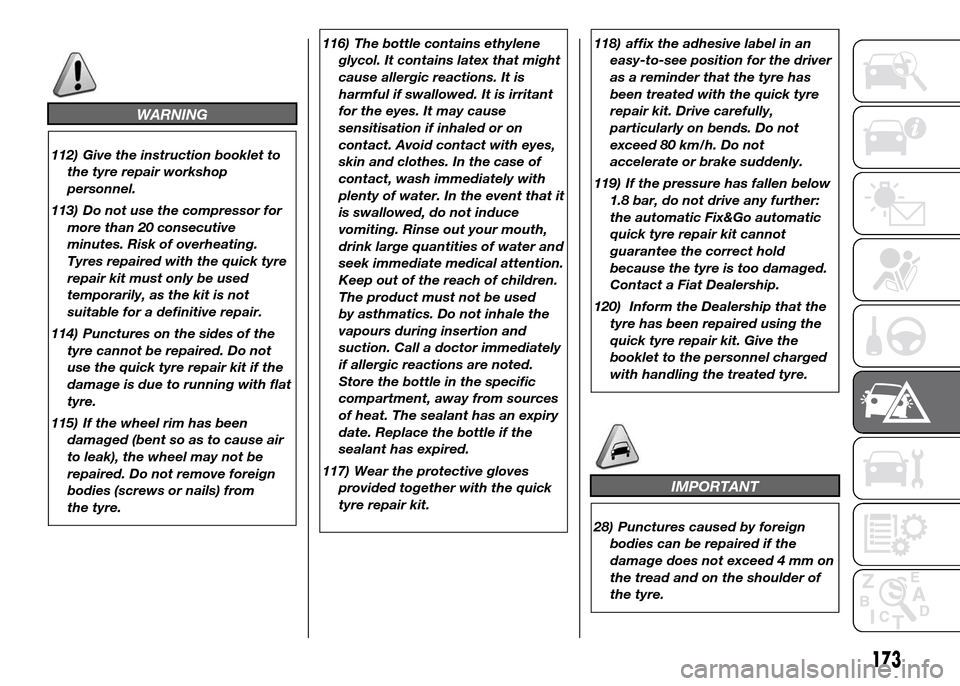2016 FIAT DOBLO PANORAMA wheel
[x] Cancel search: wheelPage 170 of 323

CHANGING A WHEEL
The vehicle is originally equipped with
the Fix&Go automatic quick tyre repair
kit (see instructions in the next section).
As an alternative, the vehicle may
have a normal-sized spare wheel.
Wheel changing and correct use of the
jack and spare wheel call for some
precautions, as listed below.
108) 109) 110) 111)
Note for one-way tyres
One-way tyres have a few arrows
on the side indicating the rotation
direction. If a wheel is changed (when
punctured, for example) the direction of
the arrows on the spare wheel tyre
may not coincide with the rotation
direction of the wheel to be replaced.
In these conditions, too, the tyre still
maintains its safety features.
Anyway, it is recommended to have the
wheel repaired and refitted as soon as
possible, as the best performance is
achieved when the rotation direction of
all tyres coincides with the one
indicated by the arrows.
Please note that:
❒the jack weight is 4 kg;
❒the jack requires no adjustment;❒the jack cannot be repaired and in
the event of a fault it must be
replaced by another original one;
❒no tool other than its cranking device
may be fitted on the jack.
To change a wheel, proceed as follows:
❒stop the vehicle in a position that is
not dangerous for oncoming traffic
where you can change the wheel
safely. The ground should be flat
if possible, and sufficiently firm;
❒stop the engine and pull the
handbrake;
❒engage first gear or reverse;
❒wear the reflective safety jacket
(compulsory by law in certain
countries) before getting out of the
vehicle;
❒indicate that the vehicle has broken
down using the devices required by
the law in the current country (e.g.
warning triangle, hazard lights, etc.);
❒for Cargo versions fig. 184: move the
left front seat forward and operate
lever A to access the tool bag; take it
to the wheel that needs replacing;❒for Doblò/Doblò Combi versions fig.
185: open the rear doors, inside the
compartment on the rear right side,
take the tool bag, unhooking the
elastic band from the buckle, and
take it next to the wheel to be
changed;
184F0V0149
185F0V0148
166
IN AN EMERGENCY
Page 171 of 323

❒take wheel spanner B fig. 186 and
the extension with pentagonal fitting
C; inside the load area, fit extension
C on bolt A; use spanner B to lower
the wheel by unwinding the wire;
❒use the wheel dismantling spanner B
to remove the wheel from the vehicle
fig. 187;
❒unscrew knob D fig. 188 and release
the rim from bracket E, removing it
from the hole of the rim;❒for versions with alloy rims, remove
the press-fitted hub cap;
❒loosen the fixing bolts of the wheel to
be replaced by about one turn, using
the spanner provided;
❒remove wedge D from the tool bag
and open it as shown in fig. 189;
❒place the wedge D behind the wheel
diagonally opposite the one you want
to replace fig. 190 to prevent the
vehicle from moving when it is raised.❒operate the jack using the knob
(release the handle from the clip and
the hole on the nut) in order to open
it partially fig. 191, then position it
under the vehicle in line with
references A fig. 192 near the wheel
to be changed.
❒operate the jack with the knob to
open it until the groove A fig. 193
of the jack is correctly inserted in the
lower profile B on the side member:
B
C
186F0V0150
187F0V0151
188F0V0193
189F0V0192
190F0V0153
167
Page 172 of 323

❒warn anybody nearby that the vehicle
is about to be lifted. They must stay
clear and not touch the vehicle until it
is back on the ground.
❒introduce the handle in the hole on
the nut and the plastic clip, then
operate the jack and raise the
vehicle, until the wheel is a few
centimetres off the ground. When
turning the crank, ensure that it
rotates freely in order to avoid grazing
your hands against the ground. The
moving components of the jack
(screws and joints) can also cause
injuries: avoid touching them. If
you become soiled with the
lubricating grease, clean it off
thoroughly;
❒fully loosen the fixing bolts and
remove the wheel;
❒make sure the contact surfaces
between spare wheel and hub are
clean so that the fastening bolts will
not come loose;
❒fit the standard wheel by inserting the
first bolt B fig. 194 two threads into
the hole closest to the inflation valve
A;
❒fit the hubcap, making sure that the
symbol
aligns with the inflation
valve, and then insert the other three
bolts.❒tighten the bolts using the spanner
provided;
❒turn the jack handle to lower the
vehicle, and remove the jack;
❒use the wrench provided to fully
tighten the bolts, passing alternately
from one bolt to the opposite one,
as per the numerical sequence
illustrated in fig. 195.
191F0V0154
192F0V0155
193F0V0156
194F0V0157
195F0V0158
168
IN AN EMERGENCY
Page 173 of 323

At the end of the
operation
❒fix bracket A fig. 196 to the wheel
after passing it through the hole,
insert the threaded pin into one of the
bolt holes and secure by tightening
knob B;
❒for vehicles with alloy rims take the
adapter D fig. 197 and fit the plastic
spacer C between the spring and the
flange of the bracket. The plastic fin
must be directed downwards and
perfectly coincide with the flange cut
part;
❒fit the bracket E fig. 198 in the
adapter D, fit the pin in the hole and
fasten by the knob F;❒position the wheel vertically and rest
the fitted adaptor on the inside of the
rim, then using the screws provided
fix the wheel to the adaptor, using the
socket wrench for the wheel nuts G
fig. 199. Tighten the screws with
the wheel removal wrench.
NOTE Use the spare wheel covering
bag to protect the replaced alloy wheel.❒Check that the position of the
replaced wheel under the platform is
correct (the lifting system is equipped
with a clutch to limit the end of the
stroke, incorrect positioning may
jeopardise safety;)
❒put the jack and the tools back in the
dedicated tool bag;
❒reposition the tool bag behind the left
side seat (Cargo versions) or, resting
the bottom of the bag against the
side panel, in the compartment inside
the rear right side (Doblò/Doblò
Combi versions).
196F0V0194
197F0V0214
198F0V0215
G
199F0V0216
169
Page 174 of 323

WARNING
108) The spare wheel (where
provided) is specifically for your
vehicle. Therefore, it must not be
used on other models. Do not
use spare wheels of other models
on your vehicle. The spare wheel
must be used only in an
emergency. Use of the spare
wheel must kept to the minimum
necessary.
109) Use your hazard lights, warning
triangle, etc. to show that your
vehicle is stationary according to
the regulations in force.
Passengers should get out of the
vehicle, particularly if it is heavily
loaded, and wait for the wheel
to be changed away from the
traffic. If you are on a slope or
uneven surface, place wedges or
other suitable objects under the
wheels to secure the vehicle.
Have the wheel repaired and
refitted as soon as possible. Do
not apply grease to the bolt
threads before assembly: they
might spontaneously unscrew.110) Use the jack only to replace
wheels on the vehicle with which
it is supplied or on other vehicles
of the same model. Never use
the jack for other purposes, such
as lifting other models. Never
use the jack to carry out repairs
under the vehicle. Incorrect
positioning of the jack may cause
the lifted vehicle to fall. Do not
use the jack for loads higher than
those shown on the label.
111) Incorrect hub cap assembly
may cause it to come off when the
vehicle is moving. Never tamper
with the inflation valve. Never
introduce tools of any kind
between rim and tyre. Check tyre
and spare wheel pressures
regularly, referring to the values
shown in the "Technical
specifications" section.
FIX&GO automatic
QUICK TYRE REPAIR
KIT
The quick repair kit Fix&Go automatic is
contained in a suitable bag inside the
compartment on the right rear side
or, for Cargo versions, under the
passenger seat (for versions with fixed
or movable seat), or in the glove
compartment (for versions with folding
seat).
The quick tyre repair kit contains fig.
200:
❒bottle A containing sealer and fitted
with: – filler tube B
– sticker C bearing the notice “max. 80
km/h”, to be placed in a position visible
to the driver (on the instrument panel)
after fixing the tyre
200F0V0093
170
IN AN EMERGENCY
Page 177 of 323

WARNING
112) Give the instruction booklet to
the tyre repair workshop
personnel.
113) Do not use the compressor for
more than 20 consecutive
minutes. Risk of overheating.
Tyres repaired with the quick tyre
repair kit must only be used
temporarily, as the kit is not
suitable for a definitive repair.
114) Punctures on the sides of the
tyre cannot be repaired. Do not
use the quick tyre repair kit if the
damage is due to running with flat
tyre.
115) If the wheel rim has been
damaged (bent so as to cause air
to leak), the wheel may not be
repaired. Do not remove foreign
bodies (screws or nails) from
the tyre.116) The bottle contains ethylene
glycol. It contains latex that might
cause allergic reactions. It is
harmful if swallowed. It is irritant
for the eyes. It may cause
sensitisation if inhaled or on
contact. Avoid contact with eyes,
skin and clothes. In the case of
contact, wash immediately with
plenty of water. In the event that it
is swallowed, do not induce
vomiting. Rinse out your mouth,
drink large quantities of water and
seek immediate medical attention.
Keep out of the reach of children.
The product must not be used
by asthmatics. Do not inhale the
vapours during insertion and
suction. Call a doctor immediately
if allergic reactions are noted.
Store the bottle in the specific
compartment, away from sources
of heat. The sealant has an expiry
date. Replace the bottle if the
sealant has expired.
117) Wear the protective gloves
provided together with the quick
tyre repair kit.118) affix the adhesive label in an
easy-to-see position for the driver
as a reminder that the tyre has
been treated with the quick tyre
repair kit. Drive carefully,
particularly on bends. Do not
exceed 80 km/h. Do not
accelerate or brake suddenly.
119) If the pressure has fallen below
1.8 bar, do not drive any further:
the automatic Fix&Go automatic
quick tyre repair kit cannot
guarantee the correct hold
because the tyre is too damaged.
Contact a Fiat Dealership.
120) Inform the Dealership that the
tyre has been repaired using the
quick tyre repair kit. Give the
booklet to the personnel charged
with handling the treated tyre.
IMPORTANT
28) Punctures caused by foreign
bodies can be repaired if the
damage does not exceed 4 mm on
the tread and on the shoulder of
the tyre.
173
Page 179 of 323

IMPORTANT Remember that the brake
booster and the electric power steering
system are not active until the engine
is started, so you will need to apply
much more force to the brake pedal or
steering wheel.
IMPORTANT
29) Never use a fast battery-charger
for emergency starting of the
engine as this could damage the
electronic systems of your vehicle,
particularly the ignition and fuel
supply control units.
WARNING
121) This procedure must be
performed by qualified personnel
as incorrect actions may cause
high-intensity electrical discharge.
Furthermore, battery fluid is
poisonous and corrosive: avoid
contact with skin and eyes. Keep
naked flames away from the
battery. No smoking. Do not cause
sparks.
FUEL CUT-OFF
SYSTEM
This intervenes in the case of an impact
causing:
❒the fuel supply cut-off with the engine
consequently switching off;
❒the automatic unlocking of the doors;
❒the switching on of the interior lights;
❒switching on of the hazard warning
lights (to deactivate the lights press
the dedicated button on the
dashboard).
122)
When the system has been triggered,
the message “Fuel cut off, see
handbook” is displayed on some
versions.
Check carefully for fuel leaks, for
instance in the engine compartment,
under the vehicle or near the tank area.
After a collision, turn the ignition key
to STOP to prevent the battery from
running down.
The following procedure should be
carried out to restore the correct
operation of the vehicle:
❒turn the ignition key to the MAR
position;
❒activate the right direction indicator;
175
Page 181 of 323

WARNING
123) Before starting towing
operations, turn the ignition key to
MAR and then to STOP, without
extracting it. If the key is
extracted, the steering lock
engages automatically and it is
consequently impossible to steer
the wheels.
124) Clean the threaded seat
carefully before fastening the ring.
Before towing the vehicle, make
sure that the tow ring is fully
tightened in its appropriate
housing. Do not start the engine
whilst the vehicle is being towed.125) When towing, remember that
greater effort is required on the
brake pedal in order to brake,
since the brake servo is not
providing assistance. Do not use
flexible cables when towing and
avoid jerky movements. During
towing operations, make sure that
the fastened joint does not
damage adjoining components.
When towing the vehicle, comply
with the specific rules of the
highway code regarding the
towing device and road conduct.
Do not start the engine whilst
the vehicle is being towed.
IMPORTANT
30) The front and rear tow hooks
should be used only for
emergencies on the road. You are
allowed to tow the vehicle for
short distances using an
appropriate device in accordance
with the highway code (a rigid
bar), to move the vehicle on the
road in readiness for towing or
transport via a breakdown vehicle.
Tow hooks MUST NOT be used
to tow vehicles off the road or
where there are obstacles and/or
for towing operations using ropes
or other non-rigid devices.
Respecting the above conditions,
towing must take place with two
vehicles (one towing, the other
towed) aligned as much as
possible along the same centre
line.
210F0V0051
177